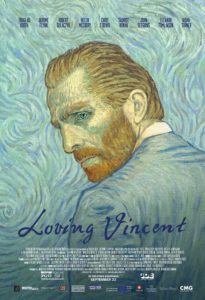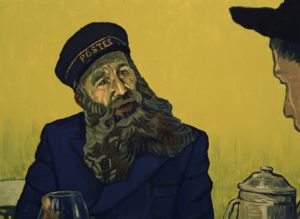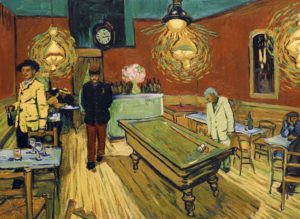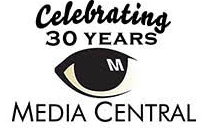By Kristin Reiber Harris

Van Gogh is arguably one of the most famous artists in the world. His artwork is certainly captivating; his use of color, the energy of his brush strokes and the sheer beauty of his work. However I believe a certain mystique that surrounds Van Gogh plays a role in his fame; the state of his mental health, his self-mutilation and his suicide and the fact that he was not well received in his time. He probably only sold one painting in this lifetime but now his paintings sell in the tens of millions, a recent sale of his work generated $66.3 million.
On October 13, the animated feature film about Vincent Van Gogh, LOVING VINCENT (trailer) will open at the Avalon Theater. I had the distinct pleasure last week of speaking with filmmakers Dorota Kobiela and Hugh Welchman. How did Kobiela and Welchman tell Van Gogh’s story? Remarkably their approach was to create the animation in the style of his paintings. They worked with 125 artists in their studios in Poland. The artists created 900 shots and 65,000 frames in a kind of hybrid rotoscoping. The film was shot with actors and then projected onto the canvas the artist were painting, but was also visible on a monitor. As I asked production questions, Dorata showed me time-lapse video of a painter working on one of the shots. They were all done using wet oil paint on canvas board, reminiscent of The Old Man and The Sea. An article in Animation Magazine is informative with production details and quotes from the filmmakers.

The plot revolves around a letter. Van Gogh’s friend, Postman Joseph Roulin asks his son to deliver a letter to Theo Gogh, Vincent’s brother, after Vincent’s death. You will definitely recognize many faces/places in the film if you are at all familiar with his work. It’s like seeing old friends. The vehicle of the letter opens up the discussion about whether Van Gogh actually killed himself or was murdered. I didn’t know this twist when I saw the film and I’m glad I didn’t. Sorry to have to tell you, but it’s in all the reviews. As an artist and lover of Van Gogh’s work it was very powerful to think that he had been able to handle his depression and had not killed himself. There is no consensus on this issue but evidence to support this theory. The filmmakers used black and white images, also in Van Gogh’s style, for the flashbacks with color image as the story unfolds after Vincent’s death. I found this approach very powerful and when I asked about their process in making this decision, Welchman indicated they felt audiences couldn’t watch an hour and a half of Van Gogh’s fully saturated color.
As I was leaving the interview I noticed, as Hugh Welchman was sitting in front of the movie poster, how much he looks like Van Gogh. When I commented on that, I’m sure not the first, he said he looks more like him now after years of researching Van Gogh’s life and creating this film.
THIS IS A WONDERFULLY AMAZING FILM YOU MUST SEE. It is poignant, beautiful and the storytelling approach is brilliant. It opens this week in LA and New York and opens in DC at the Avalon Theater on October 13. Watch the trailer for Loving Vincent here.















